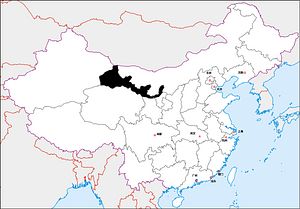This article series explores 12 distinct “regions” within China: six “core” regions long dominated by the majority Han ethnic group and six “periphery” regions home to many of China’s ethnic minorities. The series overview is available here. To view the full series, click here.
Between the Tibetan plateau’s northeast ramparts and the Gobi desert are corridors of fertile land, fed by meltwater from the mountains and the long northward leg of the Yellow River. Providing access from China proper to Xinjiang, this region was the first leg of the ancient Silk Roads. This legacy has left it with China’s main concentration of the Muslim Hui, descended from Han intermarriage with migrants from western Eurasia. In the region’s far west are the Mogao grottoes, a pilgrimage center for travelers setting off into the deserts of Xinjiang, and one of the world’s great repositories of Buddhist art.
This area saw frequent transit by Chinese armies advancing into Xinjiang and Mongolia, and nomad armies coming the other way. Its initial incorporation into China dates from the 2nd-1st centuries BCE, when the Han state launched a series of military campaigns comparable to Alexander the Great repeating his drive to India continuously for four decades, settling a million colonists in the conquered lands. The region was also strategically important for vast horse-breeding pastures unavailable in inner China, the loss of which hobbled Chinese military power versus the nomads. The “flying horse” of Gansu, excavated from a Han dynasty tomb and modeled on the famed blood-sweating steeds of Ferghana, has become a symbol of the Silk Road and of Chinese civilization.
In the 10th-12th centuries this region was ruled by a multi-ethnic Buddhist kingdom, which was so completely annihilated by Genghis Khan that it left behind only a vast tomb-mound complex and a ghost city in the desert. After the collapse of the Mongol Yuan dynasty in the 1300s, Gansu once again became the frontier between China and the Muslim lands further west – symbolized by the “last pass” of the Great Wall – until the great campaigns to destroy the last bastion of Mongol power during the 1700s brought Xinjiang under Beijing’s rule.
The Hui earned a militant reputation during the 19th and early 20th centuries, being involved in some of China’s bloodiest internal conflicts. Between the World Wars, China’s northwest was ruled by a triumvirate of Hui warlords who waged some of the most brutal campaigns of the era, including clashes with the armies of the Dalai Lama over the Tibetan frontier lands. In recent decades the Hui have been more quiescent than their Uyghur co-religionists, reflected in more lenient treatment by government policy; for instance, the ban on state employees and students fasting during Ramadan applies only in Xinjiang, not in the Hui autonomous region of Ningxia. There is little love lost between the two Muslim groups, with the Hui having played a leading role suppressing Uyghur independence in the 1930s.
Gansu today is China’s poorest province per capita, the scene of harrowing stories of poverty that occasionally prick the nation’s conscience. The province is also a kaleidoscope of China’s environmental disasters: the capital Lanzhou recently topped the World Health Organization’s global air pollution list, efforts to save tens of thousands of hectares from the advancing desert have backfired spectacularly, and farmers are being slowly poisoned by groundwater contaminated with heavy metals. The latest economic remedy is proliferating wind turbines, many standing idle due to lack of transmission lines to more developed regions.
Next up: Xinjiang.
John Lee is a former visiting fellow of the Mercator Institute for China Studies. He tweets at @J_B_C16.

































